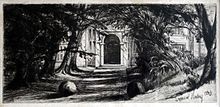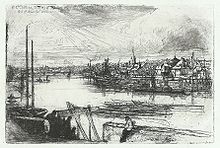Francis Seymour Haden
Sir Francis Seymour Haden (born September 16, 1818 in London , † June 1, 1910 ) was an English doctor , artist and art patron. Above all, his commitment to etching as a recognized art form is known.
life and work
His father Charles Thomas Haden was a well-known doctor and music lover. He attended Derby School , Christ's Hospital and University College London . He later also studied at the Sorbonne in Paris , where he received his diploma in 1840. In 1842 he became a member of the Medical Association and was allowed to practice as a doctor.
Between 1843 and 1844 he traveled to Italy with his friends Duval, Le Cannes and Colonel Guibout and made his first drawings based on nature. Haden did not attend art classes, but between 1845 and 1848 he occupied himself intensively with extensive print collections in a shop on Bunhill Row in the old Quaker district of London. By arranging the etchings in chronological order, he studied the works of Albrecht Dürer , Lucas van Leyden and Rembrandt van Rijn on the basis of the reproductions .
These studies influenced his own artistic activities, but also prompted him to write a monograph on Rembrandt's etchings. The memorable exhibition at the Burlington Fine Arts Club in 1877 was an important help to him. Haden now tried to reproduce a faithful representation of Rembrandt's work by rearranging the etchings and ignoring inferior quality plates. He published the results of his studies of the master's works in chronological order in the works The Etched Work of Rembrandt critically reconsidered from 1877 and Etched Work of Rembrandt True and False from 1895.
Haden married Deborah Delane Whistler, sister of James McNeill Whistler , in 1847 . They had four children together: Annie Harriet, Francis Seymour, Arthur and Harry. Haden passed his experience with printing techniques on to his brother-in-law Whistler. In 1855 a printing press was installed in Haden's apartment on Sloane Street, and for a while Haden and Whistler worked together on a series of etchings of the Thames . However, the relationship did not last too long and they broke up in an argument.
Haden promoted the technique of the original etching with such force that he was able to win over the leading exponents of British art for this technique. His energetic endeavors culminated in the establishment of the Society of Painter-Etchers in 1880 . Founding members were Hubert von Herkomer , Mansel Lewis , Alphonse Legros , James Tissot , Robert Macbeth and Heywood Hardy . Haden led the Society as the first president for many years with a firm hand. At the urging of Haden also was engraving ( Engraving ) as a gravure process considered and the Society called himself now Society of Painter-etcher and Engravers .
Regardless of his studies of the old masters, Haden also made numerous plates himself in which he presented individual landscape themes. One of his most important works is the large-format Breaking Up of the Agamemnon , in which the departure of a steamship is shown. A catalog of his works was started by William Richard Drake in 1880 and completed by Nazeby Harringtonn in 1910. Haden frequently used in later years as a gravure printing method, the mezzotint and soon developed similar artistry as the drypoint and Ätzradierung . Haden also painted with charcoal and made some notable drawings of trees and park-like landscapes.
Among the numerous awards he received was the Paris Grand Prix , which he was awarded in 1889 and 1900. Haden was also a member of the Institut de France , the Académie des Beaux-Arts and the Société des Artistes Français . In 1894 Haden was promoted to Knight Bachelor and was allowed to prefix his name with a Sir as a title of nobility . He died in 1910 at the age of 91.
Works
- 1865: Etudes a l'eau forte
- 1875: Cremation: a pamphlet
- 1877: The Etched Work of Rembrandt critically reconsidered
- 1879: About Etching
- 1883: The Relative Claims of Etching and Engraving to rank as Fine Arts and to be represented in the Royal Academy
- 1888: Address to Students of Winchester School of Art
- 1888: The Disposal of the Dead, a Plea for Legislation
- 1890: The Art of the Painter-Etcher
- 1895: Etched Work of Rembrandt True and False
literature
- Richard S. Schneiderman: A Catalog Raisonné of the Prints of Sir Francis Seymour Haden. , Garton and Co Print Dealers and Publishers, London 1983, ISBN 0906030161 .
- Richard S. Schneiderman: Sir Francis Seymour Haden. Associated American Artists, New York NY 1973 (exhibition catalog).
- Malcolm C. Salaman: Sir Francis Seymour Haden, PRE The Studio, London 1926.
- Malcolm C. Salaman: The Etchings of Sir Francis Seymour Haden, PRE Halton and Truscott Smith, London 1923.
- Nazeby Harrington: The Engraved Work of Sir Francis Seymour Haden, PRE An Illustrated and Descriptive Catalog. Henry Young & Sons, Liverpool 1910.
- William Richard Drake: A Descriptive Catalog of the etched Work of Francis Seymour Haden. Macmillan & Co., London 1880.
- Haden, Sir Francis Seymour . In: Encyclopædia Britannica . 11th edition. tape 12 : Gichtel - harmonium . London 1910, p. 797 (English, full text [ Wikisource ]).
Web links
| personal data | |
|---|---|
| SURNAME | Haden, Francis Seymour |
| BRIEF DESCRIPTION | English doctor, artist and art patron |
| DATE OF BIRTH | September 16, 1818 |
| PLACE OF BIRTH | London |
| DATE OF DEATH | June 1, 1910 |




